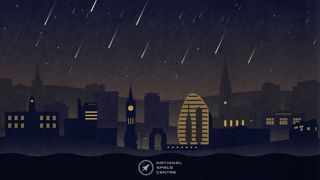
Delta Aquariid Meteor Shower 2025
- 1st Jul 2025
- Author: Team Discovery (edited: Dhara Patel)
Delta Aquariids
This year, the Delta Aquariid meteor shower is active from 12 July to 23 August. The shower doesn’t have a noticeable peak, but its expected to reach its maximum rate on 30 July.
The radiant of this meteor shower appears to come from near the star Delta Aquarii in the constellation Aquarius. The radiant will rise above the horizon in the late evening and will reach its highest point above the south-eastern horizon around 3:00am the following morning and will have a steady stream of 15-20 meteors per hour at its peak in ideal conditions. The waxing crescent moon will set in the early evening - a moonless sky will make for more favourable viewing helping your meteor-gazing efforts.
What is a Meteor Shower?
Meteor showers occur when the Earth passes through the debris of a comet. The dust and gas left behind by the comet burn up in the atmosphere causing a shooting star.
The Delta Aquariids meteor shower likely comes from the comet 96P/Machholz. It is estimated to be 6.4 kilometres in diameter and takes just over five years to complete an orbit of the Sun. This comet is known as a sungrazing comet, which is where the comet can get within 1,400,000 kilometres of the Sun on its closest approach.
How to Watch from the UK
To watch the Delta Aquariid meteor shower, face towards the south-east and scan the skies. Whilst the peak is predicted to occur during the early evening, the skies will still be light and the radiant in the constellation of Aquarius won’t have yet risen above the horizon. This is where the meteors will appear to radiate from, but make sure you look at the whole sky as they can appear all over.
The meteor shower will be best viewed just after midnight when the radiant will be higher up in the sky. Find Aquarius by looking for the square of Pegasus in the south-east, then look down towards the horizon and you will see a bright star. This isn’t actually a star – it’s Saturn, and the constellation on Aquarius lies to the right of it.
There are also other astronomical objects to spot around this time. To the left of the square of Pegasus you may be able to see a faint smudge - this is the Andromeda Galaxy! This is a great deep sky object to look at through binoculars or a telescope.
So, find a dark sky area, wrap up warm, and allow at least 20 minutes for your eyes to adjust to the low light conditions and scan the skies to enjoy the shooting stars using just the optical tool nature gave you – your eyes!
To find your nearest dark sky site use Go Stargazing.
Meteor Infographic
Meteor Infographic
Download our National Space Centre Meteor Shower Guide to make sure you are fully prepared!
Upcoming meteor showers for 2025 include:
Perseids
Comet of Origin: 109P/Swift-Tuttle
Radiant: constellation Perseus
Peak Activity: 12-13 August 2025
Peak Activity Meteor Count: up to 100 meteors per hour
Draconids
Comet of Origin: 21P/Giacobini-Zinner
Radiant: constellation Draco
Peak Activity: 8-9 October 2025
Peak Activity Meteor Count: up to 5 meteors per hour (In rare instances, fiery Draco has been known to spew forth many hundreds of meteors in a single hour.)
Orionids
Comet of Origin: 1P/Halley
Radiant: constellation Orion
Peak Activity: 21-22 October 2025
Peak Activity Meteor Count: up to 20 meteors per hour
Northern Taurids
Comet of Origin: 2P/Encke
Radiant: constellation Taurus
Peak Activity: 11-12 November 2025
Peak Activity Meteor Count: 5 meteors per hour
Leonids
Comet of Origin: 55P/Tempel-Tuttle
Radiant: constellation Leo
Peak Activity: 16-17 November 2025
Peak Activity Meteor Count: up to 10 meteors per hour
Geminids
Asteroid of Origin: 3200 Phaethon
Radiant: constellation Gemini
Peak Activity: 13-14 December 2025
Peak Activity Meteor Count: up to 150 meteors per hour
Ursids
Comet of Origin: 8P/Tuttle
Radiant: constellation Ursa Minor
Peak Activity: 21-22 December 2025
Peak Activity Meteor Count: up to 10 meteors per hour
Happy meteor-gazing!
Full references / credits:
(Banner image) Meteor shower alert. Credit: National Space Centre
(1) Comet 96P Machholz, the parent of the Delta Aquariid meteor shower taken from the HI-2 camera of the STEREO-A spacecraft in 2007. Credit: STEREO-A (public domain)
(2a) The radiant of the Delta Aqauriids in Aquarius. Credit: Stellarium
(2b) Group of people stargazing. Credit: Kendall Hoopes (public domain) https://www.pexels.com/photo/silhouette-of-people-stargazing-2901134/
(3) Meteors infographic. Credit: National Space Centre





